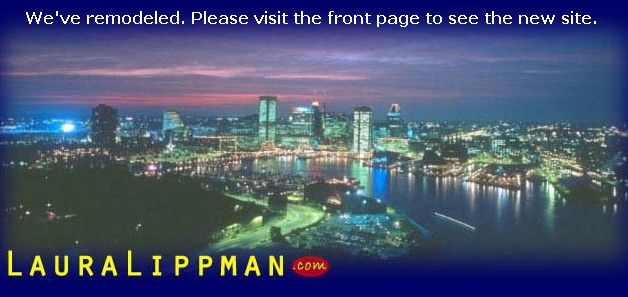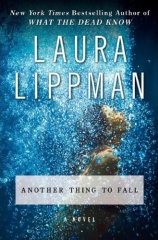



September 2025
168,307
168,307. That's how many words of fiction I have written in the past eight months. The tally includes a novel, Life Sentences, which I sent to my editor last week; a novella, Scratch a Woman, written for the short story collection Hardly Knew Her, to be published Oct. 7; and another, much longer novella, The Girl in the Green Raincoat, which will be serialized in the New York Times Magazine starting Sunday, September 7.
I'm not sure I should make this number public. With the exception of Anthony Trollope, prolific writers are suspect in our culture. I've seen -- and, in fact, even received -- reviews that suggest writers would be better served by slowing down. It's less common, I think, for critics to spank novelists for slacking. In fact, they tend to be rather charitable and even ingenuous, accepting on blind faith that a writer who takes many years to produce a book is working on that book every day of those many years. Haven't they heard of Scrabulous? Online poker?
When I started as a crime writer, my heroes included Lawrence Block, Donald Westlake and Ed McBain/Evan Hunter, writers known for breadth and speed. I heard them explain at various conferences that their swiftness was a result, in part, of a market where there was healthy demand for material, but low per-word rates. If you wanted to support yourself as a writer, you had to write a lot. So they did. But they were also uncommonly good writers. (Still are, in the case of Block and Westlake; Hunter died in 2025.)
The fiction market has changed, to risk hilarious understatement. The standard in crime fiction is one book a year. Unless it isn't. The smartest publishers -- well, mine, I have no idea what the others say -- insist that they want writers to go at their own best speed. Dennis Lehane and Sara Paretsky are two outstanding writers who chose not write at that pace. Ken Bruen exceeds it. John Connolly maintains it -- by the skin of his teeth, according to this wonderful blog post at his site. I'm on the record as saying I wish I had fourteen months to write a book, so I could waste two. Yet, year after year, no matter how the books vary, the timetable stays eerily the same. Even when, as in this year, I do far more work than I expected. (For the record, my high-water mark for impossible years will always be 1998. My deadline had to be moved up two months. I was teaching. And working fulltime at the Sun, where I found out in late summer that I would be joining the team of reporters covering the Maryland governor's race. That was the year I spilled a glass of wine on my laptop. I don't think that was incidental.)
We tend to approach the subject of production as one of speed: How fast can you go? How fast is too fast? Taught as children that haste makes waste, we can't help thinking that books would be that much better if writers would take that much longer.
But what if we recognize that novel-writing might be more akin to a gestational period? Because it's not only about the writing, as I discovered when I left my fulltime job in 2025. It's the steeping, the amount of time one spends immersed in the work. Thinking, eating right, taking those pre-novel vitamins. (AKA, reading other books.) A rabbit has a baby in 33 days; an Asian elephant requires 645. Does that make an elephant better than a rabbit?
True, gestational variance is all about size, and the metaphor breaks down there. I still hew to the old journalism adage that writing tighter takes longer. ("Dear Mother, I am writing you a long letter because I don't have time to write a short one.") The real flaw in the draft that I sent to New York is not the speed at which I wrote it, but the fact that it's 112,000 words. That's too much. Which is why I've already started rewriting it. The plan is to try to get through another draft by Bouchercon in Baltimore, then another draft after that, than the copy-editing draft . . . . In short, I really have at least three months to go.
Meanwhile, if you want to meet Lawrence Block, he will be at Bouchercon as the Lifetime Achievement Guest of Honor. Charles Ardai will interview him Oct. 11 - but you have to be registered to attend.

Speaking of Bouchercon - Some Eating Advice
For the past few months, I've received several e-mails asking me to compile a list of recommended restaurants near the hotel. I'm not sure why people assume I eat so much. Is it the books? Does this website make me look fat? But at any rate, I'm going to give it my best shot here, with a couple of caveats:
WALKABLE
- The hotel is in a section of downtown Baltimore where I seldom eat. However, the organizers did some important fieldwork on a recent visit, and you'll find their picks at the Charmed to Death blog. With one exception, noted below, I am confining myself to restaurants where I have eaten within the past two years, with one noted exception. I recommend that people check the Chowhound boards and Elizabeth Large's restaurant blog for consenting and dissenting views.
- I have very liberal ideas about what constitutes walking distance. To me, anything under a mile is walkable. Just a few days ago, I walked 2.2. miles to have dinner at Mezze. (This is only 1.6 miles from the hotel. I recommend the roasted salmon, lima beans with a side order of feta and the baba ganoush.) So I have broken my list down to "Walkable" (.5 miles or less); Walkable for Some (.6-1 mile); Walkable for the Intrepid (1.1-1.5); and Get a Cab. Meanwhile, all walking distances are according to Google's walking directions, a function currently in beta. I found some of the mileage and routes suspect; I strongly recommend asking someone at the hotel for the best walking route. (Um, not me. Someone who actually works at the hotel. Please?)
- To orient visitors: Baltimore Street is the dividing line between north and south. Except in the case of St. Paul, which becomes Light Street south of Baltimore.
- Baltimore taxis always seem expensive to me, relative to other cities, and I have been in cabs where the meters were rigged. A five-mile ride should cost somewhere between $12 and $15.
- I didn't link to the restaurant websites. Google your own way there for menus, hours, et cetera. I've also avoided chain restaurants, but some of the more notable ones near the hotel include Morton's, Ruth's Chris, P.F. Chang's, Fogo de Chao, Hard Rock Café, Chipotle and Potbelly Sandwich Works.
Lexington Market*, 400 W. Lexington. This is just under a half-mile from the convention hotels. Home of the best crabcake in Baltimore, at Faidley's. Bear in mind, I was taught as a journalist not to use unique qualifiers - the best, the only, the first - because it's so easy to be wrong. I stand by my assertion that the all-lump crabcake is the best.
Cypriana*, 130 E. Baltimore St., .3 of a mile. I love the sandwiches here, especially the grilled chicken with extra feta. Although pricey, they're huge. Good salads, too. There's carry-out, and a nice seating area outdoors.
Harborplace*, .5 (maybe a teeny bit more). There are few local restaurants left in this landmark development by the Rouse Co. It's mostly chains, but there's enough variety to satisfy the most diverse groups. And it's not touristy; lots of locals come here for weekday lunches or weekend afternoons.
WALKABLE FOR SOME
The Helmand*, .806 N. Charles St., .8 miles. One of Baltimore's most reliable restaurants, and a relative bargain for the experience.
Donna's, 800 N. Charles, .7 miles. Good light fare for lunch and it serves beer and wine.
The Brass Elephant*, 924 N. Charles Street, .8 miles. The upstairs lounge, Tusk, is the place to go. One of Baltimore's prettiest bars.
Red Maple, 930 N. Charles Street, .8 miles. Good sushi and other light fare. Hip for Baltimore. Used to ban blue jeans. Has $4 tapas at 5-7 Happy Hour and the kitchen is open until midnight on the weekends.
The Owl Bar*, 1 E. Chase Street, 1 mile. Good bar food. Study the stained glass owls and ponder the missing panel.
Iggie's, 818 N. Calvert, .9 miles. Good pizza, named for a greyhound, what's not to love? BYOB. Also, tables are communal and diners buss their own plates.
Baltimore's Farmers Market, 407 E. Saratoga St., .5 miles. (Sunday only, stands usually open by 7 a.m., although official start is 8 a.m.) Walk down Fayette, then left on Holliday Street; the market is actually under the expressway. If you're looking for an offbeat Sunday breakfast - you know to hold you until the scintillating 10 a.m. Guest of Honor interview - you could do much worse. Tucked among the local produce are stands selling fresh, hot miniature doughnuts, crepes, sandwiches and barbecue. A total scene, too, one of the few city events that draws a truly diverse group of people. The Hollywood Diner is adjacent.
WALKABLE FOR THE INTREPID
South of Downtown
Thai Arroyo, 1019 S. Light St, 1.1 mile. BYOB.
Ryleigh's, 36 E. Cross St., 1.1 mile. Good oyster bar, exceptional burger - everything I've sampled here has been fine-to-good. Rowdy on weekends.
Spoons Coffee Café, 24 E. Cross Street, 1.2 miles. Breakfast and lunch only. Do not bother the lady who is writing.
Matsuri, 1105 S. Charles St., 1.2 miles. (Note: Google walking directions send people down Light Street, but there's no reason not to walk down Charles, which cuts at least a tenth of the mile off the route.) I eat here at least once a week.
East of Downtown
Cinghiale/Charleston, 822 Lancaster Street, 1.2 miles. These are two of my favorite restaurants in Baltimore. Both are pricey, and I would recommend a reservation for Charleston. At Cinghiale, I prefer the large bar, Enoteca, to the more formal dining rooms.
Mezze*, 1606 Thames Street, see above.
Pazo, 1425 Aliceanna, 1.3 miles. Another restaurant in the Charleston Group, which is owned by Cindy Wolf and Tony Foreman. Incredibly hip by Baltimore's standards.
Peter's Inn, 504 S. Ann St., 1.6 miles. (OK, technically not in this category, but Mezze is also a tenth of a mile beyond my parameters.) It can be hard to get a table here, but it's worth it.
GET A CAB (ALL LESS THAN FIVE MILES, WITH ONE EXCEPTION)
The Ambassador*, 3811 Canterbury Road. Indian food in lovely, peaceful surroundings. Bonus: Sujata Massey once lived in this elegant old apartment building.
Golden West*, 1105 W. 36th Street. I've never understood the mix of food available here, which includes Tex-Mex, New Mexican Mex, Indian, Thai, Vietnamese and American comfort food. Some things don't need to be understood; Golden West manages to do almost everything well. Come for the sopapillas, stay for the shopping along Hampden's "Avenue," which is lined with funky stores, including the divine Ma Petit Shoe, which sells shoes and chocolate.
Jack's Bistro, 3123 Elliott Street, just off the square in Canton. For the adventurous.
Paper Moon*, 227 W. 29th St. Open 24 hours. Menu used to include an appetizer called "Hummuside: Life on the Pita." I like the restaurant in spite of this. Great omelets.
Petit Louis*, 4800 Roland Avenue. This is slightly more than six miles from the hotel. Owned, again, by Wolf and Foreman. A boisterous bistro in the heart of one of Baltimore's prettiest neighborhoods.
(If you read Chowhound, you will find people who aren't as enchanted with Wolf's restaurants as I am. And in interest of full disclosure, Tony Foreman once bought me a glass of port.)
The Wine Market*, 901 Fort Avenue. Only a little more than two miles from the hotel, this restaurant has plenty of parking, which makes it quite the novelty in South Baltimore. Good food and the wine is a great bargain, as there's a store attached and they sell it only fifteen percent the store price.
Woodberry Kitchen,2010 Clipper Park Road. The only restaurant on the list that I haven't visited, but a friend with an impeccable palate swears by it.
*Denotes a restaurant featured in a Tess Monaghan novel.

